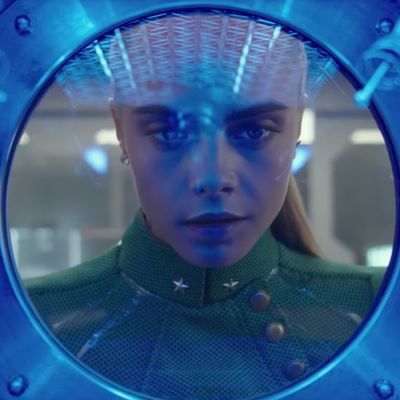
If you go in expecting an uneven (to be generous) script, you won’t be disappointed by one of the sci-fi events of the year: Luc Besson’s daft, virtuosic epic Valerian and the City of a Thousand Planets, based on a much-loved series of French comic books. It’s what happens when an artist with an unfettered visual imagination gets hold of the latest computer technology and goes all-out, budget be damned. He choreographs teeming, high-speed ballets of actors and bizarro creatures and sci-fi gizmos, any minute of which features more cinematic magic than the last four Star Wars movies combined.
The plot? Fuzzy, but the opening is ingenious. It charts the evolution over centuries of a space city, to which evermore immense/squiggly/aesthetically upending (to earthlings) alien emissaries arrive and shake hands (or the mystifying cultural equivalent) with their human hosts. That “city of a thousand planets” is called Kyrian, and it’s where knowledge and culture are shared among as many species. It’s also where our male and female heroes, federal agents, are summoned to investigate some sort of anomaly … I forget what it is exactly, apart from a McGuffin.
The heroes don’t have much chemistry but sure are purty. Dane DeHaan plays Valerian, who supposedly has nine years of space swashbuckling under his swash (or buckle) but looks about 19. The bags beneath his blue eyes give him a worldly air and he’s a cutie, but his voice is in the Keanu Reeves dead zone, and Valerian’s alleged horn-dog tendencies don’t come through. His partner is Laureline, played Cara Delevingne. The jury’s out on whether Delevingne can act, and lines like, “My heart will belong to a man who will erase his playlist” don’t make her job easier. But she has the right attitude (tart, amused), and Besson’s camera loves her. Besson loves bodies in general, in iridescent colors and varieties of shapes — thin and spindly, fat and jiggly, all of them in constant, harmonious motion. His gaze is a mixture of fetishistic and childlike. Those fetishes seem almost pre-sexual.
He’s in his element in the second sequence, on a beach on a planet called Mul, where a stringy, elongated female with luminous skin gazes in joy at a doglike creature that shakes off gems like water droplets. This idyllic existence (the design suggests a pipe dream of ancient Egypt) is disturbed by giant spaceships that darken the sky — what looks like an invasion but turns out to be a rain of downed vessels from a war raging above.
It might as well be an invasion, though: It destroys the planet. But the young female we’ve been following sends her life force… or over-spirit… or something across the galaxy and into the body of Valerian.
Dang, the plot is hard to follow. Besson runs an insanely successful movie factory out of his studio in the Paris suburbs, but there’s not enough quality control over scripts — particularly his own. The comic-book series that fired his imagination has clean, straightforward narratives, even when the protagonists are hurtling back and forth in time. But in Valerian and the City of a Thousand Planets, you never know quite what the characters are doing and why.
The remedy? Let it go, let it go. Ogle sequences that are instant classics. Early on, Valerian materializes in a virtual tourist bazaar with virtual shops that stretch into the horizon, leaping in and out of dimensions as he strives to catch … someone … and attempts to elude … someone else. A huge dog-beast launches itself onto the agents’ flying bus and smashes its way and nearly swallows everyone — until the vehicle jumps into hyperspace and the creature plummets toward the ground with a look that would make Wile E. Coyote whimper in sympathy. The movie wasn’t shot in 3-D, but the retrofitting is gorgeous, with a dizzying number of planes on which a dizzying number of events unfold: Spring for the glasses and gasp as Valerian runs straight through a wall, tumbles into space, and jets past innumerable hives of activity on innumerable levels.
In a sequence that’s essentially a long digression from the main plot, Rihanna (as a shape-shifter) does a cabaret act while metamorphosing into different characters with different costumes and hairstyles — pig-tailed schoolgirl, twitch-and-slink Liza Minnelli vamp, and more. The magic disappears when she has to speak (and worse, act) but as the movie goes on, it can use a few guest stars. (A preening Ethan Hawke plays the showman who has enslaved poor Rihanna.) A child with a Japanese Teletubbie-like face is a treat, but the most entertaining aliens are called the Doghan Daguis, a trio of furry, fast-talking quasi-ducks who act as “information brokers” and finish one another’s sentences. Maybe it’s time to remake Howard the Duck. Or not.
I worry that people will minimize Besson’s achievement because of his herky-jerky script, but Valerian and the City of a Thousand Planets is more than the sum of its effects. Marvel movies might have better dialogue (waves of screenwriters see to that), but the designs and effects feel as if they’ve been generated by a committee. As a mogul, Besson doesn’t worry about pleasing his corporate masters. He and his visual effects supervisor, Scott Stokdyk, can expend all their energy on topping themselves and making each other laugh. The movie is like a wave that makes you want to yell, “Cowabunga!”


